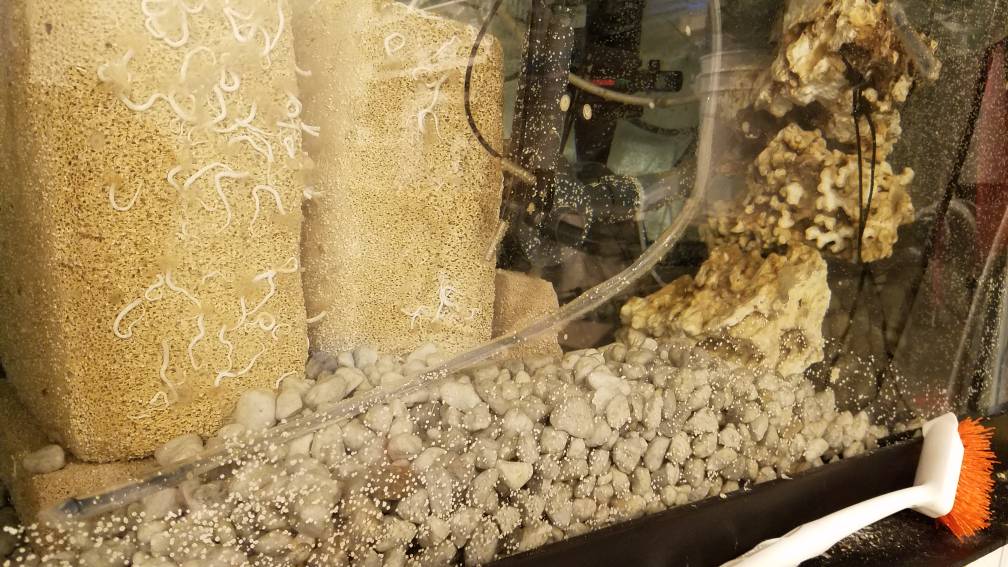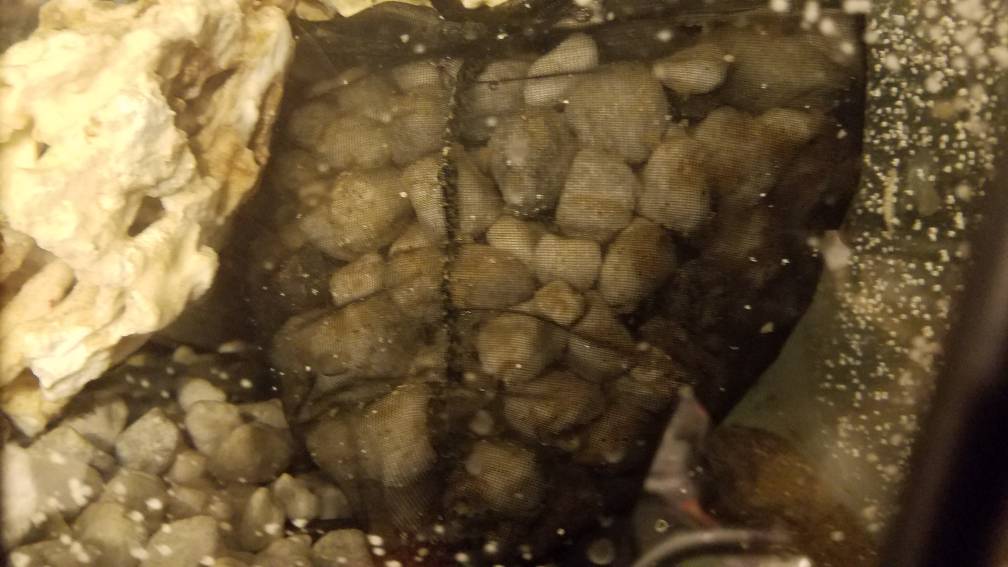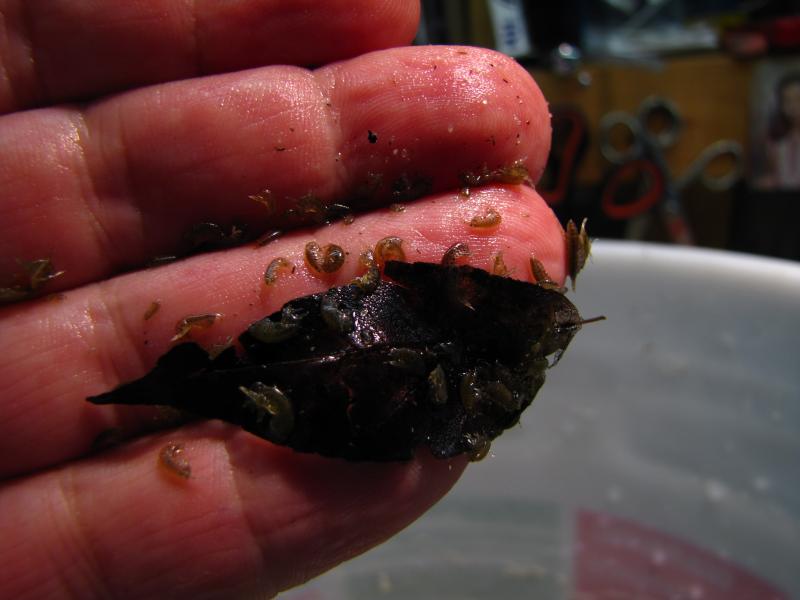Navigation
Install the app
How to install the app on iOS
Follow along with the video below to see how to install our site as a web app on your home screen.
Note: This feature may not be available in some browsers.
More options
You are using an out of date browser. It may not display this or other websites correctly.
You should upgrade or use an alternative browser.
You should upgrade or use an alternative browser.
How to make a Tank Last for 40 years with few problems
- Thread starter Paul B
- Start date
- Tagged users None
- Joined
- Jul 28, 2015
- Messages
- 4,668
- Reaction score
- 3,191
Just took this video to see some of the pods swarming around
Its an unlit sump with an ATS above it.
This is a post of its design which I just siliconed up some glass
https://www.reef2reef.com/threads/best-sump-features-to-date.274203/page-5#post-3500331
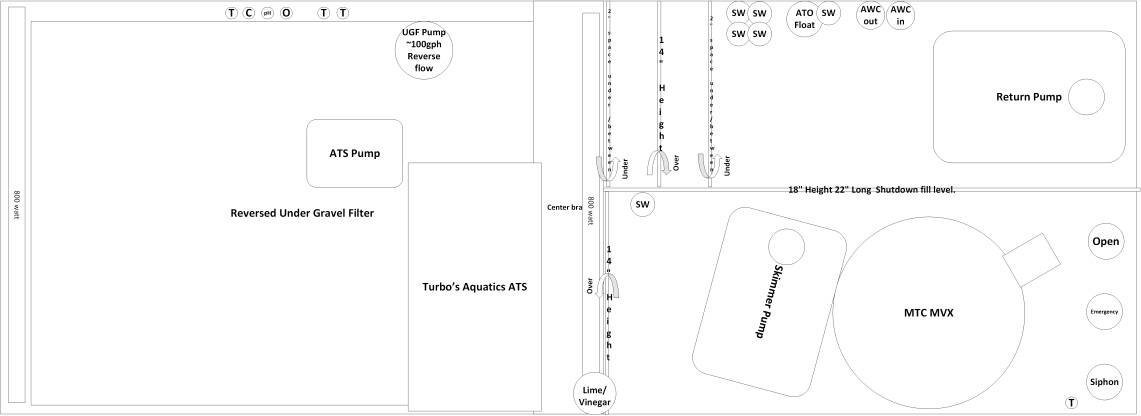
Its an unlit sump with an ATS above it.
This is a post of its design which I just siliconed up some glass
https://www.reef2reef.com/threads/best-sump-features-to-date.274203/page-5#post-3500331

Kind of old thread. Anyone else have any thoughts of running a natural/immune tank or does everyone else just quarantine and run a sterile, IMO, not normal tank? 
Kind of old thread. Anyone else have any thoughts of running a natural/immune tank or does everyone else just quarantine and run a sterile, IMO, not normal tank?
@Paul B I'm finding you everywhere as I research on feeding live natural food! I'm starting my first saltwater tank (I've kept lots of freshwater) and it's currently cycling with a couple dead shrimp. Now, I don't even like feeding my dog dry, processed foods (she is on the raw diet if you've heard of it). Ever since switching her over to this diet her coat, teeth and activity levels have improved drastically. She no longer gets dry, itchy skin like she used to. So I'm completely sold on feeding my fish fresh sea food. I live in Tampa Florida so this shouldn't be too hard. I think I will feed clam, fish, and worms if possible. I know it's easy to find live clams around here but when feeding fish I'm assuming it's best to buy whole fish and not something like a filet from publix? Do these fish need to be gutted or just chopped up and froze? I'm also thinking of collecting things such as shells, seaweed, and sand from the beach to hopefully add bacteria and parasites and such. I do have access to a boat but I'm not sure where to find tide pools to collect goodies
Elisa h, thank you for responding. The tide pools in Tampa will be much less full of life than the tide pools we have here in New York. Feeding fish will be tough unless you can get very tiny fish. Grinding up larger fish will give you a huge, smelly mess as the liver is almost all oil and that oil (which is extremely healthy for the fish and for us) stinks. The best foods you can feed (and easily get) are clams, mussels, oysters and worms. You can als smash snails. Do not use fish fillets from Publix. Get the largest shellfish you can find and freeze it. Then slice off paper thin slices.
If everyone did this, (and didn't quarantine) there would be no reason for disease forums as that diet along with natural bacteria will keep your fish immune from just about anything. They will also look much better as you discovered with your dog. I would use absolutely no dry foods, no pellets, no flakes and certainly no freeze dried anything as those foods are devoid of any live bacteria.
You can suppliment your fresh seafoods with something commercial like LRS foods. I do that because it is sometimes a little of a pain to get enough clams. But I do try to feed at least some live blackworms with every meal and I believe that diet has kept my fish immune for decades.
Here is an article I wrote on feeding. http://www.saltwatersmarts.com/want-healthy-spawning-fish-feed-them-properly-5010/
If everyone did this, (and didn't quarantine) there would be no reason for disease forums as that diet along with natural bacteria will keep your fish immune from just about anything. They will also look much better as you discovered with your dog. I would use absolutely no dry foods, no pellets, no flakes and certainly no freeze dried anything as those foods are devoid of any live bacteria.
You can suppliment your fresh seafoods with something commercial like LRS foods. I do that because it is sometimes a little of a pain to get enough clams. But I do try to feed at least some live blackworms with every meal and I believe that diet has kept my fish immune for decades.
Here is an article I wrote on feeding. http://www.saltwatersmarts.com/want-healthy-spawning-fish-feed-them-properly-5010/
- Joined
- Aug 14, 2017
- Messages
- 1,233
- Reaction score
- 1,743
Kind of old thread. Anyone else have any thoughts of running a natural/immune tank or does everyone else just quarantine and run a sterile, IMO, not normal tank?
I've run a tank like that with my own wild caught fish. I had zero disease. It's funny but I got into a similar conversation on a reptile forum. A guy asked if it would be okay to feed some bugs he caught to some lizards he caught. I said of course. Some guy jumped all over me about parasites and such. I said they were living on the local fauna just fine before this guy caught them. I guess he thought crickets are raised in sterile conditions.
BTW, the pic with the beer can made me laugh. A long time ago I did a freshwater tank with fish from a local quarry. Since it was polluted I put a crushed Old Milwaukee can in it. A baby channel cat lived in it. People thought I was nuts.
Maybe I'll do it again when I resurrect my South Florida biotope tank, though that did use collected sand in it.
awesome article as usual.
Really enjoy your thoughts.
I just use a refugium with macro algae to balance out and stabilize operation. And the diy 2 part.
Still use my diatom filters on my planted FW tank and am even dreaming up ways of getting it setup faster and easier.
my .02
Really enjoy your thoughts.
I just use a refugium with macro algae to balance out and stabilize operation. And the diy 2 part.
Still use my diatom filters on my planted FW tank and am even dreaming up ways of getting it setup faster and easier.
my .02
Thanks for posting Flsalty and Beas.
It always amazes me that many people feed sterile foods and quarantine for 72 days and wonder why their fish always have problems.
It always amazes me that many people feed sterile foods and quarantine for 72 days and wonder why their fish always have problems.
- Joined
- Aug 14, 2017
- Messages
- 1,233
- Reaction score
- 1,743
Thanks for posting Flsalty and Beas.
It always amazes me that many people feed sterile foods and quarantine for 72 days and wonder why their fish always have problems.
But what do you think about doing this with captive bred fish that have no natural immunity to anything?
Brew12
Electrical Gru
View BadgesExcellence Award
Reef Tank 365
Article Contributor
Moderator Emeritus
North Alabama Reef Club
Article Administrator
My Tank Thread
I can share my opinion on this. Fish have two main parts to their immunity. Innate and adaptive. In my opinion it is very important for fish to have a strong innate immune system. One of the best ways to do this is to keep fish in a low stress environment while using high quality food. If a fish has a strong innate immunity they will have more time for their adaptive immunity to develop when exposed to a parasite.But what do you think about doing this with captive bred fish that have no natural immunity to anything?
But what do you think about doing this with captive bred fish that have no natural immunity to anything?
There are very few captive bred fish in the industry so far except for some clowns, seahorses, Bangai cardinals and a very few others. Baby fish acquire their immunity from their Mother and if she was a wild fish, the babies will have immunity for a certain period of time and if they are raised correctly with live food, they will maintain their immunity. If not, it will take a long time to acclimate fish to pathogens and it must be done gradually but the first step would be to feed food with live bacteria at almost every meal. I personally never tried to get captive fish immune.
Hello Paul,
I was directed by one of the other members here to your contributions to this forum, and I think what you are doing is very interesting.
I consider myself an old-timer as well, as I have been keeping fish since I was 5 and I am now 45, but you have been doing it longer than I have been alive. I was there and remember some of the same events in the hobby that you do.
I was an undergravel filter loyalist and advocate, and actually made a DIY reverse-flow undergravel filter before they were a thing, by connecting a powerhead in reverse, and using a sponge to filter the water first, this was before Marineland actually made a product that did that. I also did one where I connected the output of a canister filter to one. And oh god you are still actively using diatom filters... I remember those, although I shifted to Marineland Magnum's fairly early on, mostly because I did not want to get electrocuted ;-)
The way you are using yours is very interesting, by using a slow flow of water, you are allowing for a small amount of denitrifying bacteria to exist, along with all the rest. Much like what is happening in live rock with the berlin system.
Until I read about your methods, I too subscribed to the idea that undergravel filters are bad and especially so in salt water tanks, let alone reef tanks. I was also convinced that wet/dry filters were bad as well, for some of the same reasons, even though I think they are great used correctly. I think in both cases the key is to hit them with water already filtered by some other method, so that they don't clog so easily.
Even knowing that, I am not sure I would put one into a reef tank now. As you mention, you need to clean it out once or twice a year, as is typical for undergravel filters. But, would you not have to then tear down or re-arrange / move around all the coral? Seems a shame to do that when it appears to take months / years to get the corals right where people want them. Although I also hear that eventually the pile of live rock and reef might also need a clean out. One thing I have seen is people "suspending" the reef above the substrate, and then use a suction tube with a 90-degree bend to be able to reach everywhere with no un-reachable areas. And I am also thinking what would stop you from putting one in your sump? Interesting stuff.
Until now I have always done freshwater aside from some dabbling in fish-only a long time ago (in the 80's). In fact my current build was going to be the mother-of-all Cichlid tanks, but my wife talked me into going salt/reef when she said the magic words - "I don't care how much it costs".... the main thing that was preventing me from getting into it before now. But, I am actually happy, I read one of your stories here about you eventually getting bored with the guppies and being saved by salt water with blue damsels... I too think I may have needed a new challenge, because I reached the point in freshwater where I could basically keep and breed fish indefinitely. The only reason I don't have a long-running tank was because I moved or lost interest in that particular setup. When I was a teenager I had six aquariums and I worked in a fish store maintaining their 70 aquariums. This eventually burned me out just as I went away for college.
I think a key aspect of my experience is my parents bought me a used 5 gallon tank and a goldfish bowl at a flea market when I was 5. At that time, information about how to keep fish properly was scarce... the local fish store not helpful, and I was not at an age where I readily could find or consume books easy enough for my level.
So, I had horrible trouble for probably 2-3 years, lost tanks full of fish, attempting using medications, I got very upset and my father even tried to talk me out of it, saying maybe keeping fish was not for me. But, I stuck with it, and eventually found a system that worked, through empirical trial and error. Later on I "reverse engineered" my methods and learned about the nitrogen cycle and various other things. From reading some of your stories that sounds similar to what you might have done to get where you are. I also eventually was able to find some great mentors who took me further and faster at various points.
So, I think if nothing else, I now feel a little less restrained by some of the "laws of physics" proclaimed by many reef keepers, which I was already starting to question in the back of my mind but didn't really dare bring up, because I was the one asking for help.
Your disclaimer about the natural vs. sterile reef keeping methods is very important. And it would indeed take some balls for a person using the sterile method to convert over to the natural method.
I will continue reading and following along. I live in Boston and I am from Cape Cod, so I have plenty of access to the ocean, but I did not think it was a good idea to mix the things local to me with things from the tropics, and the risk of pollution near the shore. That even if it survived, it would expose the tropical fish to bacteria and parasites they would have no immunity to. So I will have to think about that. I did work with some people running reef tanks who used real sea water, and what an operation that was with 150 gallon tanks....! This guy had trash barrels in his garage cycling water with airstones, that he would fill from the ocean with his rusty pickup truck.
Lastly, I do actually have a question. You speak of these blackworms and such, where do you get a steady supply of those? And what kinds of things sourced locally would you recommend for live / fresh food? I could walk down the street to the bait shop that has sea worms, the one's with the black claws that bite you. And down on Cape Cod I would have access to all manner of things.
Aside from that, thank you very much for your contributions.
-JCL
I was directed by one of the other members here to your contributions to this forum, and I think what you are doing is very interesting.
I consider myself an old-timer as well, as I have been keeping fish since I was 5 and I am now 45, but you have been doing it longer than I have been alive. I was there and remember some of the same events in the hobby that you do.
I was an undergravel filter loyalist and advocate, and actually made a DIY reverse-flow undergravel filter before they were a thing, by connecting a powerhead in reverse, and using a sponge to filter the water first, this was before Marineland actually made a product that did that. I also did one where I connected the output of a canister filter to one. And oh god you are still actively using diatom filters... I remember those, although I shifted to Marineland Magnum's fairly early on, mostly because I did not want to get electrocuted ;-)
The way you are using yours is very interesting, by using a slow flow of water, you are allowing for a small amount of denitrifying bacteria to exist, along with all the rest. Much like what is happening in live rock with the berlin system.
Until I read about your methods, I too subscribed to the idea that undergravel filters are bad and especially so in salt water tanks, let alone reef tanks. I was also convinced that wet/dry filters were bad as well, for some of the same reasons, even though I think they are great used correctly. I think in both cases the key is to hit them with water already filtered by some other method, so that they don't clog so easily.
Even knowing that, I am not sure I would put one into a reef tank now. As you mention, you need to clean it out once or twice a year, as is typical for undergravel filters. But, would you not have to then tear down or re-arrange / move around all the coral? Seems a shame to do that when it appears to take months / years to get the corals right where people want them. Although I also hear that eventually the pile of live rock and reef might also need a clean out. One thing I have seen is people "suspending" the reef above the substrate, and then use a suction tube with a 90-degree bend to be able to reach everywhere with no un-reachable areas. And I am also thinking what would stop you from putting one in your sump? Interesting stuff.
Until now I have always done freshwater aside from some dabbling in fish-only a long time ago (in the 80's). In fact my current build was going to be the mother-of-all Cichlid tanks, but my wife talked me into going salt/reef when she said the magic words - "I don't care how much it costs".... the main thing that was preventing me from getting into it before now. But, I am actually happy, I read one of your stories here about you eventually getting bored with the guppies and being saved by salt water with blue damsels... I too think I may have needed a new challenge, because I reached the point in freshwater where I could basically keep and breed fish indefinitely. The only reason I don't have a long-running tank was because I moved or lost interest in that particular setup. When I was a teenager I had six aquariums and I worked in a fish store maintaining their 70 aquariums. This eventually burned me out just as I went away for college.
I think a key aspect of my experience is my parents bought me a used 5 gallon tank and a goldfish bowl at a flea market when I was 5. At that time, information about how to keep fish properly was scarce... the local fish store not helpful, and I was not at an age where I readily could find or consume books easy enough for my level.
So, I had horrible trouble for probably 2-3 years, lost tanks full of fish, attempting using medications, I got very upset and my father even tried to talk me out of it, saying maybe keeping fish was not for me. But, I stuck with it, and eventually found a system that worked, through empirical trial and error. Later on I "reverse engineered" my methods and learned about the nitrogen cycle and various other things. From reading some of your stories that sounds similar to what you might have done to get where you are. I also eventually was able to find some great mentors who took me further and faster at various points.
So, I think if nothing else, I now feel a little less restrained by some of the "laws of physics" proclaimed by many reef keepers, which I was already starting to question in the back of my mind but didn't really dare bring up, because I was the one asking for help.
Your disclaimer about the natural vs. sterile reef keeping methods is very important. And it would indeed take some balls for a person using the sterile method to convert over to the natural method.
I will continue reading and following along. I live in Boston and I am from Cape Cod, so I have plenty of access to the ocean, but I did not think it was a good idea to mix the things local to me with things from the tropics, and the risk of pollution near the shore. That even if it survived, it would expose the tropical fish to bacteria and parasites they would have no immunity to. So I will have to think about that. I did work with some people running reef tanks who used real sea water, and what an operation that was with 150 gallon tanks....! This guy had trash barrels in his garage cycling water with airstones, that he would fill from the ocean with his rusty pickup truck.
Lastly, I do actually have a question. You speak of these blackworms and such, where do you get a steady supply of those? And what kinds of things sourced locally would you recommend for live / fresh food? I could walk down the street to the bait shop that has sea worms, the one's with the black claws that bite you. And down on Cape Cod I would have access to all manner of things.
Aside from that, thank you very much for your contributions.
-JCL
But, would you not have to then tear down or re-arrange / move around all the coral? Seems a shame to do that when it appears to take months / years to get the corals right where people want them.
Hello JCL and thank you for that nice long post. Most people write things like "Duh" or "Oh Yeah" or "you wouldn't know a moray eel from a goldfish".
I like long posts as I myself am wordy.
I also spoke in Boston a couple of years ago.
About the UGF, I don't move rocks to clean the gravel. Like you mentioned almost all of my rocks are up on DIY rock pillars so not much of them is touching the gravel. That allows me to get my diatom filter in there and stir everything up. Of course I can't get everywhere but whatever I can reach seems to be enough. While I do that I also blast the rocks in between the corals to clean out the pores. That is a yearly task and takes an hour. I don't spend time testing, tweeking, quarantining, curing, medicating or changing much water so I have time for other things.
In Boston you can use the water, but not from the harbor. From the harbor you can collect amphipods under rocks in the intertidal zone and from the bait shop you can use those "sandworms" but don't let them bite you. They are large so you need to chop them small or first freeze them. Excellent food. You can also probably get clams at the bait shop. Freeze them and shave off paper thin slices for the fish. You can adjust the size of the slices for the size of the fish. I feel worms and clams are the best food there is and if you can get those saltwater sand worms, that is perfect.
Nice to meet you.
Hello JCL and thank you for that nice long post. Most people write things like "Duh" or "Oh Yeah" or "you wouldn't know a moray eel from a goldfish".
I like long posts as I myself am wordy.
I also spoke in Boston a couple of years ago.
Well, I too am often accused of being too wordy... I type fast and I like details. Most often I get the "TLDR"....
About the UGF, I don't move rocks to clean the gravel. Like you mentioned almost all of my rocks are up on DIY rock pillars so not much of them is touching the gravel.
Do you have any pictures of the pillars you use and how you implement them? This is something I have been thinking about.
I really like the "suspended in mid air" effect, such as what you can see in this thread here: https://www.reef2reef.com/threads/aquascaping-what-are-the-best-ways-to-hold-it-together.218324/ And I was thinking that it might have the side-benefit of being able to reach those areas to clean...
My favorite undergravel filter was the heavy-duty white or black one's made by Lee's or Perfecto, I must have sold thousands of them when I worked at a fish store. https://www.amazon.com/Premium-Undergravel-Filter-18-Inch-72-Inch/dp/B0002APVB6
Using one on a 6' tank would be crazy powerful. Imagine if you used one with a closed-loop (outputs under the plates), you would have a completely invisible setup.
These days I am more apt to go with a wet/dry, because it can basically do the same job at a higher capacity and excellent gas exchange, but it would not do the anaerobic part that you are accomplishing. Easy to clean though if you wash it in aquarium water. But I would still be chastised for using it on a reef tank.
But, if you have a sufficiently good nitrate export method, and you clean it occasionally, I don't see what the issue is, I just never thought to question it. I wonder who started the stigma?
That allows me to get my diatom filter in there and stir everything up. Of course I can't get everywhere but whatever I can reach seems to be enough. While I do that I also blast the rocks in between the corals to clean out the pores. That is a yearly task and takes an hour. I don't spend time testing, tweeking, quarantining, curing, medicating or changing much water so I have time for other things.
I see. I always thought that all the rocks in any reef tank would eventually mean a tear-down (undergravel filter or not). But blasting stuff out with a water jet is an interesting way to do it, and you have gone this long with just vacuuming what you can reach, so it obviously works unless there is something else I am missing. Running the tank that long I would think you would eventually see things like hydrogen sulfide, but I have never actually heard of that happening, might be more of an aquarium urban legend.
In Boston you can use the water, but not from the harbor.
So, are you using real seawater? If I did I would get away from city. But water is heavy, getting enough of it would either take many trips or a truck and some large containers. And I think my friends would think if finally went off the deep end....
That being said, I have been looking into doing this no-water-change Triton method, so once I had the "starting water" maybe it would not be so bad, if there are real tangible benefits. And I would imagine it would not preclude also using artificial seawater later off and on.
From the harbor you can collect amphipods under rocks in the intertidal zone and from the bait shop you can use those "sandworms" but don't let them bite you. They are large so you need to chop them small or first freeze them. Excellent food. You can also probably get clams at the bait shop. Freeze them and shave off paper thin slices for the fish. You can adjust the size of the slices for the size of the fish. I feel worms and clams are the best food there is and if you can get those saltwater sand worms, that is perfect.
Nice to meet you.
OK, would this regimen be the main approved food source that would be needed to support your methods? I actually saw your message while I was out and about today, so I stopped by one of the better bait shops nearby http://santinitube.com/.
I told the guy what I was doing, and he said he actually already did that for many nearby zoos, aquariums, fish hatcheries and so forth. He can get the night crawlers year-round and they are cheap, about $12 a box. But, the nice saltwater seaworms from Maine (nereis viren) are a bit pricey at $78 for a box of 125 worms. Not sure how long you could keep them alive, but that could get expensive. You can see the list of stuff they have on the website, they do offer clams by the pint and gallon. And a bunch of other things that I am not sure about.
I am assuming freezing the worms would kill them, would bacteria and other things you are after survive?
Overall I should not be surprised by this, I am no stranger to live and fresh food with freshwater fish, especially if you are breeding them.
But, before I get carried away with excitement on this, I don't know if it is for me yet. I see in one of your articles you specifically say this is "not for noobs", and even with my freshwater experience, I am probably mostly a noob on reef tanks. Also read you pointing out that running a "sterile" tank vs. your "natural" method was a different philosophy, and you might run into trouble when trying to incorporate animals from sterile environments into the "natural" method environment. So there are potentially some compatibility issues, and you might be on your own if you run into problems using an "unorthodox" method.
I see that you wrote a book, perhaps I should read that first.
Nice to meet you as well.
-JCL
JCL, again, thank you for the post. Here is the beginnings of my "rock" pillars.
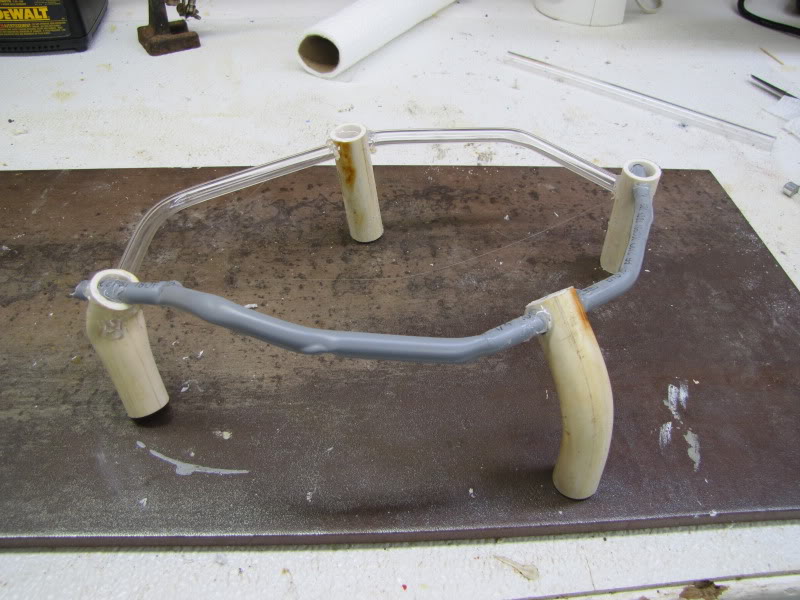
Then the finished product. My reef is supported off the gravel by these which are simple to build and almost free. I wrote an article about how to build them if you like. (it is also in my book but if you read my threads you can get all that information)
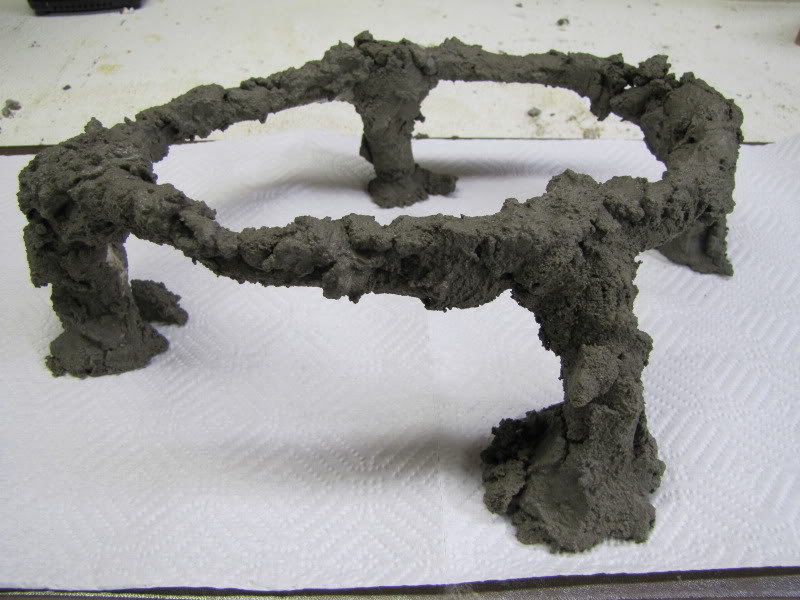
More examples of my home made "hollow" rock.
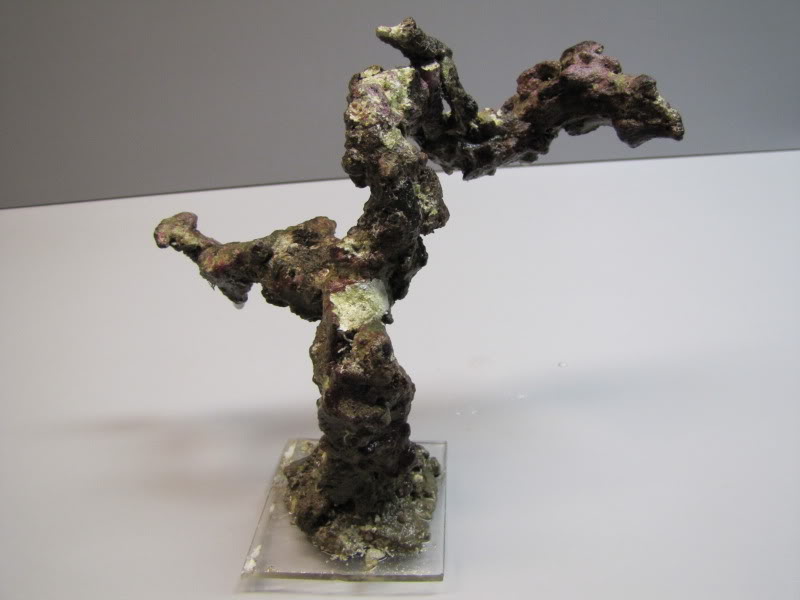
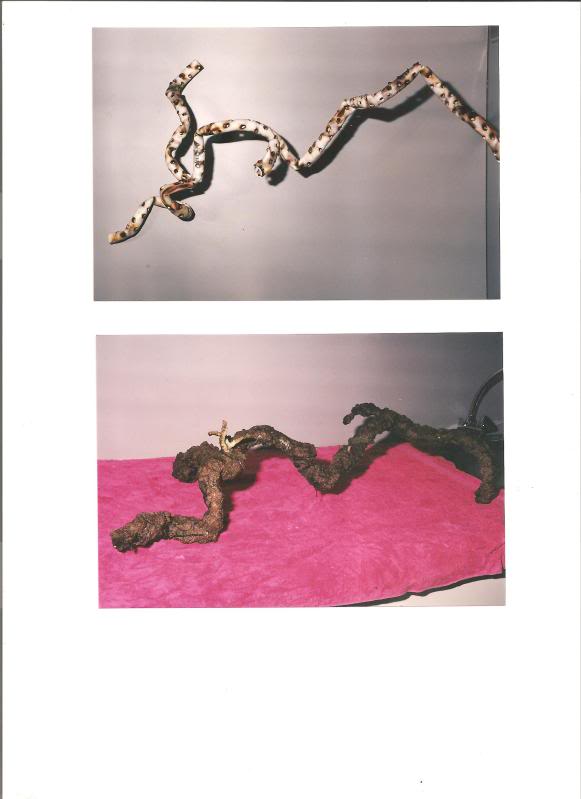
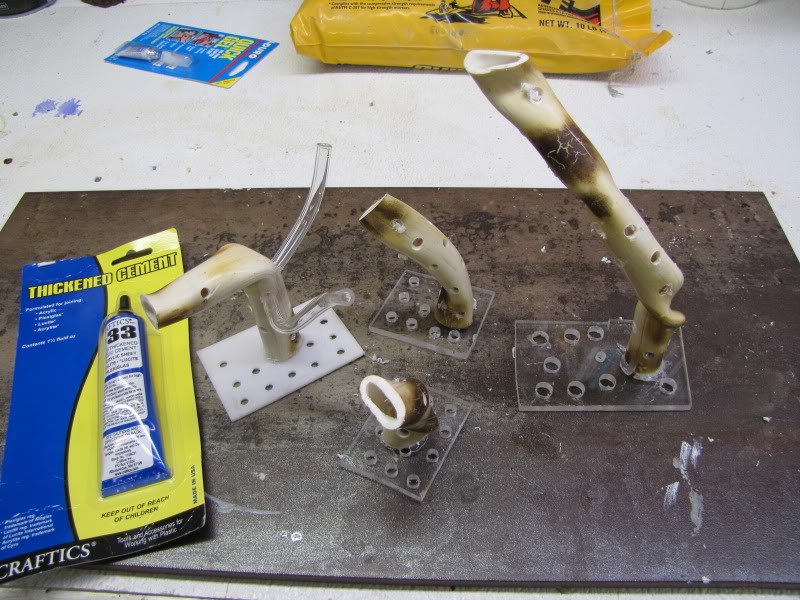
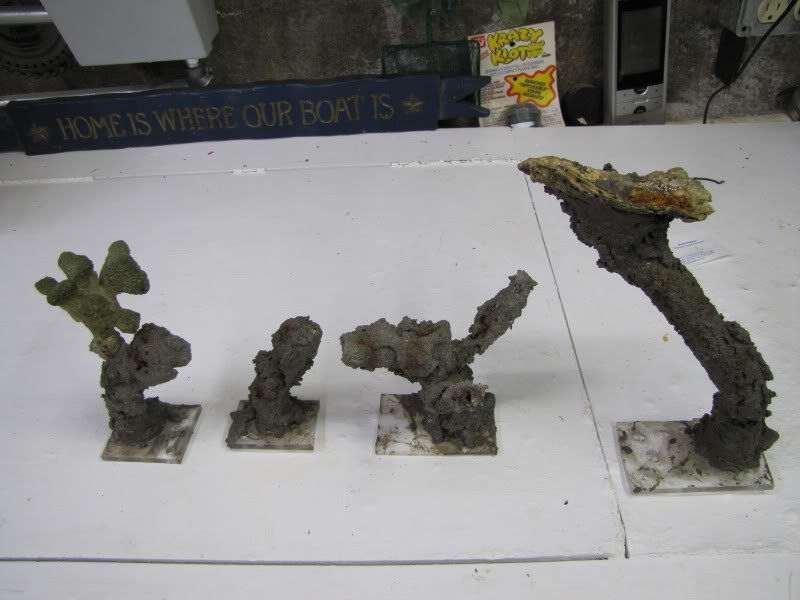
My reef was started with NSW but now I am older and it doesn't get any lighter so I only have a very little NSW in my tank because I didn't collect any this year. When I move shortly, I will fill the tank with NSW as I will be near the beach.
The sand worms are great and you can freeze them and chop them small. Your home freezer won't kill the bacteria so they are good as are the clams. You can get the clams at the bait shop or a supermarket and freeze them. It is better if you can buy themalive and freeze them yourself because in a bait shop they could have been frozen 5 years ago.
My tank is also 6' long. It's hard to tell but most of my rock is above the gravel.
You will also have to use something like LRS food which is excellent as it will be a pain to get all natural worms and clams.
I wrote many threads on here that address your questions.
Again, thanks.
Paul
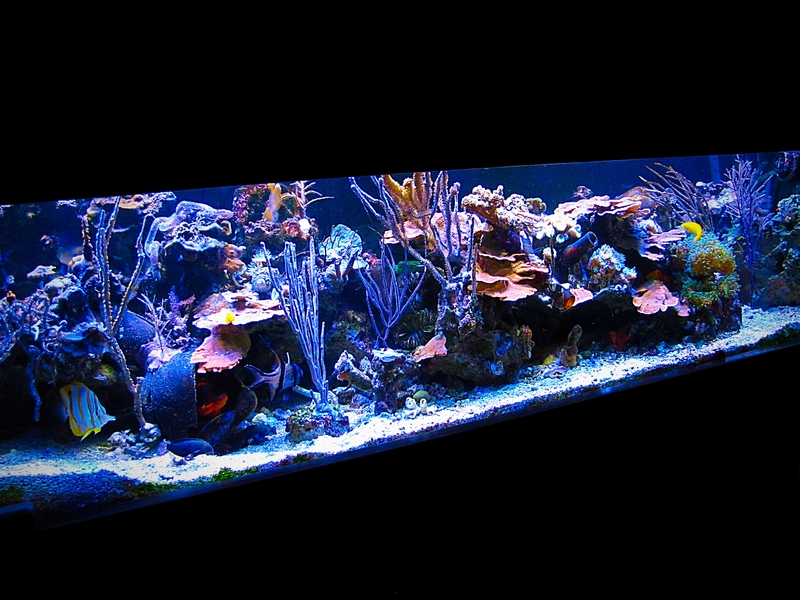

Then the finished product. My reef is supported off the gravel by these which are simple to build and almost free. I wrote an article about how to build them if you like. (it is also in my book but if you read my threads you can get all that information)

More examples of my home made "hollow" rock.




My reef was started with NSW but now I am older and it doesn't get any lighter so I only have a very little NSW in my tank because I didn't collect any this year. When I move shortly, I will fill the tank with NSW as I will be near the beach.
The sand worms are great and you can freeze them and chop them small. Your home freezer won't kill the bacteria so they are good as are the clams. You can get the clams at the bait shop or a supermarket and freeze them. It is better if you can buy themalive and freeze them yourself because in a bait shop they could have been frozen 5 years ago.
My tank is also 6' long. It's hard to tell but most of my rock is above the gravel.
You will also have to use something like LRS food which is excellent as it will be a pain to get all natural worms and clams.
I wrote many threads on here that address your questions.
Again, thanks.
Paul

Kind of old thread. Anyone else have any thoughts of running a natural/immune tank or does everyone else just quarantine and run a sterile, IMO, not normal tank?
You already know my thoughts which are not dissimilar in many ways to yours Paul.
Re Quote from one of your posts " They don't have a long memory so I don't think they remember the trip or the Styrofoam box or plastic bag"
I use a DIY feeding tube to feed my fish and broadcast to my corals, my fish have come to recognise when I put the tube in the tank to feed that food will come out od the end. A number of my fish will immediately peck at the tube as if to hurry the food out. Now if I go away for a week and the feeding tube has not been used then as soon as I use the tube on my return to feed them they are there once again pecking at the tube waiting for their food to emerge. Now I am not saying they have remembered but they have certainly been conditioned to recognise that the tube means food is imminent. Is there a difference between memory and conditioning? Am not sure but somebody with an ology will be along shortly to explain I guess.
I wish I had a way to collect wild pods for food..
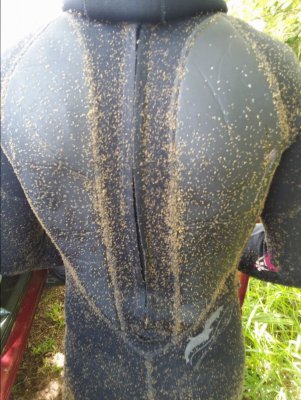
Be sure to check LOCAL regulations on open/closed for clam/oyster/mussel harevsting. Sometimes it can be a few miles of water to go from legal to illegal. Sometimes a recent storm, red tide, bad water sampling, population managment, etc. will close off a specific area.
(Your locale open/closed) http://shellfish.floridaaquaculture.com/seas/seas_southgulf.htm
That link is also updated often and can give you a good heads up of whats what.

I know it's easy to find live clams around here
Be sure to check LOCAL regulations on open/closed for clam/oyster/mussel harevsting. Sometimes it can be a few miles of water to go from legal to illegal. Sometimes a recent storm, red tide, bad water sampling, population managment, etc. will close off a specific area.
(Your locale open/closed) http://shellfish.floridaaquaculture.com/seas/seas_southgulf.htm
That link is also updated often and can give you a good heads up of whats what.
Good read. I appreciate people like you taking the time to educate the youngster generation. Being pioneers on your own back then you've made it through some stuff, and figured it out without the internet. Amazing.
Interesting perspective in the original post. I would not doubt the years of trial an error that's evolved. I was a bit surprised when you mentioned "under gavel filter". It reminds me of my first complete 10 gallon freshwater aquarium traded for a Ricky Henderson rookie card probably 30 years ago. But I understand the theory. For some of those reasons I agitate my sand to the bottom every day after feeding. And went barebottom on another. I must admit I've always felt barebottom to be lacking.
With the parasite theory I agree, but having gone through a lot prior to my last build I decided for the first time to start a tank from scratch using only dry rock and adding fish quarantined in copper for a month. I will say this may be a totally sterile, environment, but it's also the only tank that I've never experienced one single fish issue or death since day one. Anymore I'm happy with the fish I have and about the delicate corals. Hopefully I didn't speak too soon, as this tank is less then two years old, but houses a beautiful healthy powder blue. The downside of this method is that I've had a hard time getting to rocks to cure, and has had me monitoring corals ridiculously close. Because of that I don't think I'd do it again, despite the cost savings.
I took extra note to your feeding methods. I agree. With my lfs being small, how do you go about getting live food? I offer a variety of frozen foods daily, but I agree, it's not the same as live with the guts included. Have you ever used earth worms from a bait shop and chopped them up?
Interesting perspective in the original post. I would not doubt the years of trial an error that's evolved. I was a bit surprised when you mentioned "under gavel filter". It reminds me of my first complete 10 gallon freshwater aquarium traded for a Ricky Henderson rookie card probably 30 years ago. But I understand the theory. For some of those reasons I agitate my sand to the bottom every day after feeding. And went barebottom on another. I must admit I've always felt barebottom to be lacking.
With the parasite theory I agree, but having gone through a lot prior to my last build I decided for the first time to start a tank from scratch using only dry rock and adding fish quarantined in copper for a month. I will say this may be a totally sterile, environment, but it's also the only tank that I've never experienced one single fish issue or death since day one. Anymore I'm happy with the fish I have and about the delicate corals. Hopefully I didn't speak too soon, as this tank is less then two years old, but houses a beautiful healthy powder blue. The downside of this method is that I've had a hard time getting to rocks to cure, and has had me monitoring corals ridiculously close. Because of that I don't think I'd do it again, despite the cost savings.
I took extra note to your feeding methods. I agree. With my lfs being small, how do you go about getting live food? I offer a variety of frozen foods daily, but I agree, it's not the same as live with the guts included. Have you ever used earth worms from a bait shop and chopped them up?
Similar threads
- Replies
- 59
- Views
- 1,741
- Replies
- 4
- Views
- 146
- Replies
- 32
- Views
- 540
- Replies
- 1
- Views
- 68
New Posts
-
-
-
Waterbox 175 infinia reef question
- Latest: Randy Holmes-Farley



